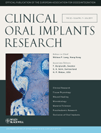Effects of a calcium phosphate coating on the osseointegration of endosseous implants in a rabbit model
Abstract:
Objectives: The aim of the present study was to evaluate a Ca–P coated implant surface in a rabbit model. The Ca–P surface (test) was compared to the titanium porous oxide surface (control) in terms of bone-to-implant contact (BIC) and removal torque value.
Materials and methods: Two hundred and sixteen dental implants were inserted in the tibia and in the femur of 36 rabbits. One hundred and eight were represented by Ca–P oxidized surface implant and other 108 were titanium porous oxide surface modified implants. Each rabbit received six implants. Animals were sacrificed after 2, 4 and 9 weeks of healing. Each group included 12 rabbits. The femoral implant and the proximal implant of the tibia of each animal were subjected to the histologic analysis and the distal implants of the tibia underwent removal torque test (RTQ).
Results: Histological analysis in terms of BIC and RTQ did not revealed any significant difference between the Ca–P oxidized surface and the oxidized surface at 2 and 4 weeks. At 9 weeks, the oxidized surface demonstrated better results in terms of RTQ in the tibia.
Conclusion: In conclusion, findings from the present study suggested that the Ca–P coating had no beneficial effect in improving bonding strength at the bone–implant interface either at 2, 4 and 9 weeks.
To cite this article: Fontana F, Rocchietta I, Addis A, Schupbach P, Zanotti G, Simion M. Effects of a calcium phosphate coating on the osseointegration of endosseous implants in a rabbit modelClin. Oral Impl. Res. 22, 2011; 760–766doi: 10.1111/j.1600-0501.2010.02056.x




